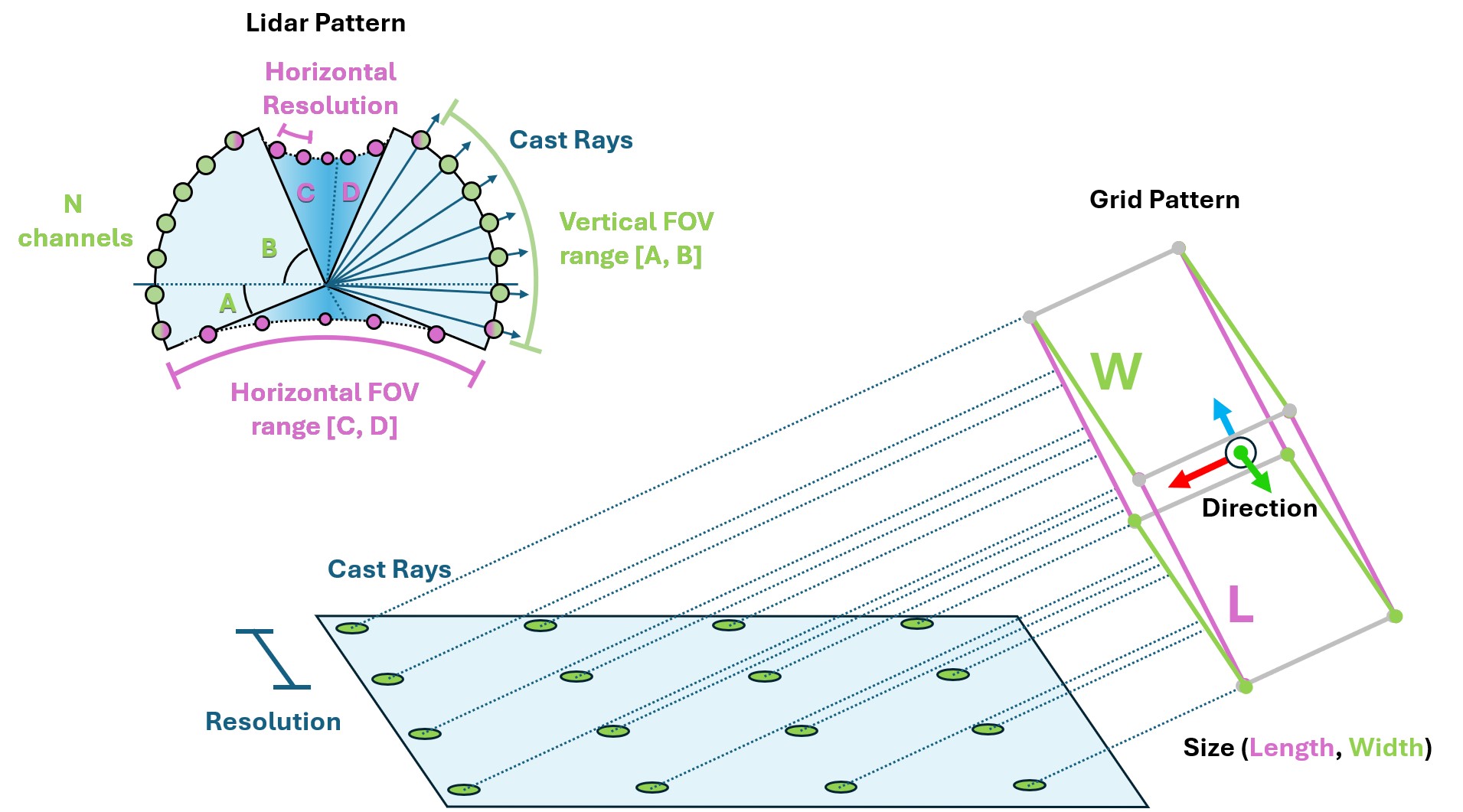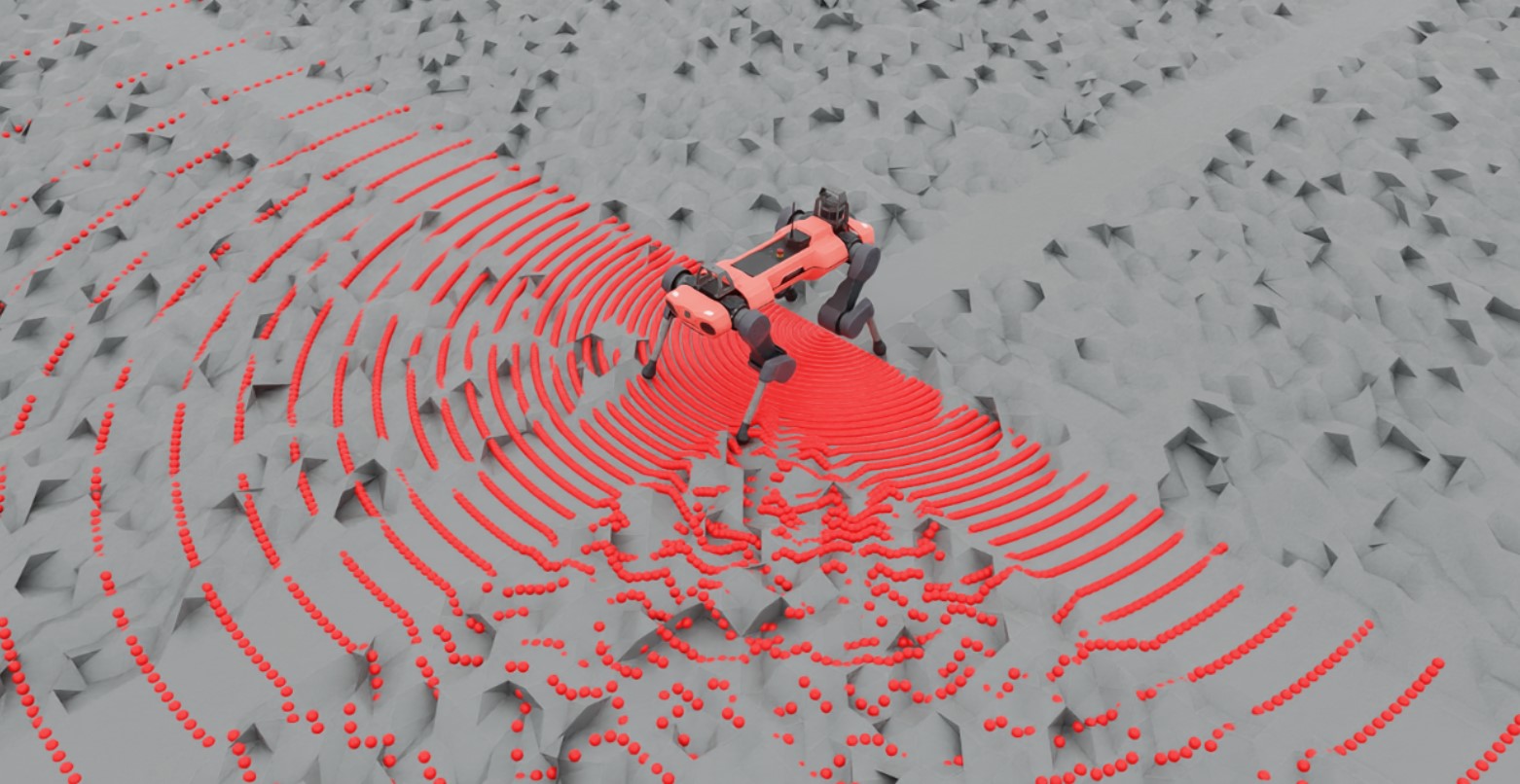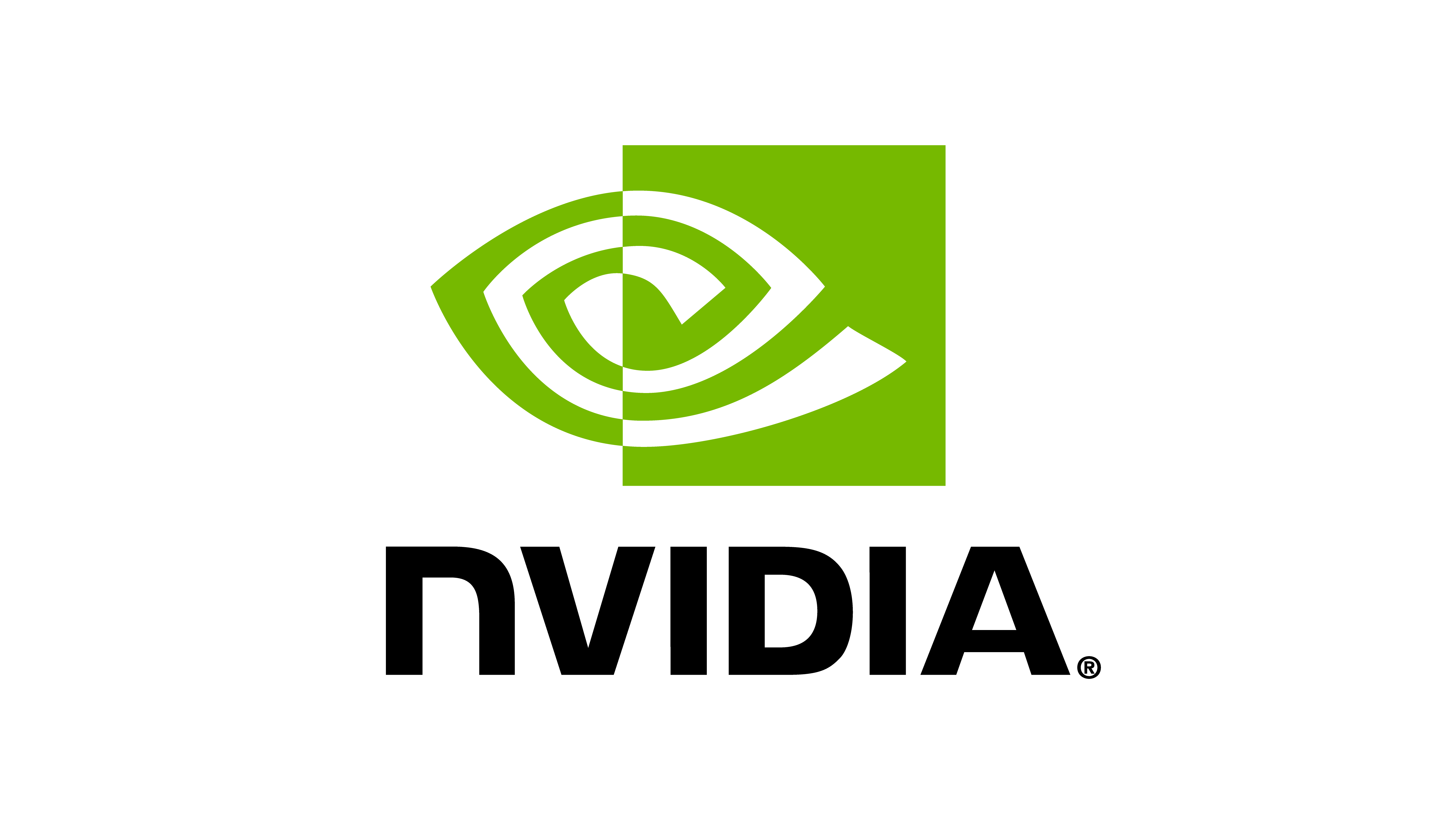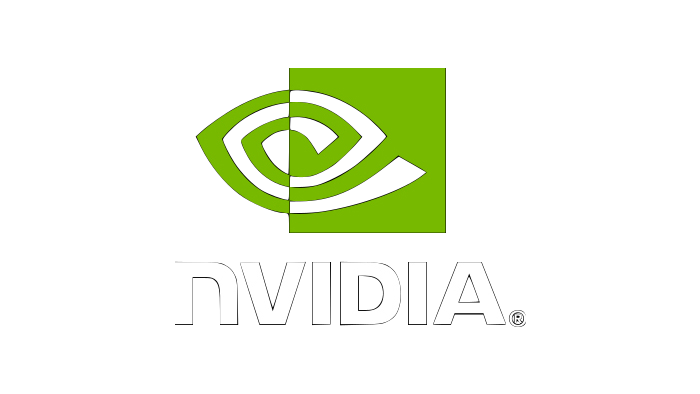光线投射#

Ray Caster传感器(以及ray caster相机)与基于RTX的渲染类似,二者都涉及到射线投射。不同之处在于,Ray Caster传感器投射的射线严格返回沿投射路径的碰撞信息,并且每条射线的方向可以被指定。它们不会反弹,也不受材质或不透明度等因素的影响。对于传感器指定的每条射线,会沿射线路径追踪一条线,并返回与指定网格的第一次碰撞位置。这是我们的一些四足动物示例中用于测量局部高度场的方法。
为了保持传感器在有多个克隆环境时的性能,线条追踪直接在 Warp 中完成。这就是为什么需要识别特定网格以进行碰撞的原因: 当传感器初始化时,warp 会将这些网格数据加载到设备上。因此,当前版本的传感器仅适用于字面上的静态网格(即 那些没有从其 USD 文件中指定的默认值发生变化的 网格)。这个限制将在未来的版本中移除。
使用光线投射传感器需要附加一个 模式 和一个父级 xform。模式定义了光线如何投射,而 prim 属性定义了传感器的方向和位置(可以指定额外的偏移量以实现更精确的放置)。Isaac Lab 支持多种光线投射模式配置,包括通用的 LIDAR 和网格模式。
@configclass
class RaycasterSensorSceneCfg(InteractiveSceneCfg):
"""Design the scene with sensors on the robot."""
# ground plane
ground = AssetBaseCfg(
prim_path="/World/Ground",
spawn=sim_utils.UsdFileCfg(
usd_path=f"{ISAAC_NUCLEUS_DIR}/Environments/Terrains/rough_plane.usd",
scale=(1, 1, 1),
),
)
# lights
dome_light = AssetBaseCfg(
prim_path="/World/Light", spawn=sim_utils.DomeLightCfg(intensity=3000.0, color=(0.75, 0.75, 0.75))
)
# robot
robot = ANYMAL_C_CFG.replace(prim_path="{ENV_REGEX_NS}/Robot")
ray_caster = RayCasterCfg(
prim_path="{ENV_REGEX_NS}/Robot/base/lidar_cage",
update_period=1 / 60,
offset=RayCasterCfg.OffsetCfg(pos=(0, 0, 0.5)),
mesh_prim_paths=["/World/Ground"],
attach_yaw_only=True,
pattern_cfg=patterns.LidarPatternCfg(
channels=100, vertical_fov_range=[-90, 90], horizontal_fov_range=[-90, 90], horizontal_res=1.0
),
debug_vis=not args_cli.headless,
)
注意,模式配置上的单位是以度为单位!另外,我们在这里启用了可视化功能,以便在渲染中明确显示模式,但这不是必需的,并且在性能调优时应该禁用。

查询传感器的数据可以像其他传感器一样在仿真运行时进行。
def run_simulator(sim: sim_utils.SimulationContext, scene: InteractiveScene):
.
.
.
# Simulate physics
while simulation_app.is_running():
.
.
.
# print information from the sensors
print("-------------------------------")
print(scene["ray_caster"])
print("Ray cast hit results: ", scene["ray_caster"].data.ray_hits_w)
-------------------------------
Ray-caster @ '/World/envs/env_.*/Robot/base/lidar_cage':
view type : <class 'isaacsim.core.prims.xform_prim.XFormPrim'>
update period (s) : 0.016666666666666666
number of meshes : 1
number of sensors : 1
number of rays/sensor: 18000
total number of rays : 18000
Ray cast hit results: tensor([[[-0.3698, 0.0357, 0.0000],
[-0.3698, 0.0357, 0.0000],
[-0.3698, 0.0357, 0.0000],
...,
[ inf, inf, inf],
[ inf, inf, inf],
[ inf, inf, inf]]], device='cuda:0')
-------------------------------
在这里,我们可以看到传感器本身返回的数据。首先请注意,开始和结束处有 3 个闭括号: 这是因为返回的数据是按传感器的数量进行分批的。射线投射模式本身也已经被压平,因此数组的维度是 [N, B, 3] ,其中 N 是传感器的数量,B 是模式中投射的射线数量,3 是投射空间的维度。最后,请注意,这个投射模式中的前几个值是相同的: 这是因为 lidar 模式是球形的,我们已将视场(FOV)指定为半球形,这包括了极点。在这种配置下, “压平模式” 变得显而易见: 前 180 个条目将是相同的,因为它是该半球的底极,并且会有 180 个条目,因为我们的水平视场是 180 度,分辨率为 1 度。
您可以使用此脚本来实验不同的模式配置,并通过修改第 81 行的 triggered 变量来建立对数据存储方式的直觉。
raycaster_sensor.py 的代码
1# Copyright (c) 2022-2025, The Isaac Lab Project Developers.
2# All rights reserved.
3#
4# SPDX-License-Identifier: BSD-3-Clause
5
6import argparse
7import numpy as np
8
9from isaaclab.app import AppLauncher
10
11# add argparse arguments
12parser = argparse.ArgumentParser(description="Tutorial on adding sensors on a robot.")
13parser.add_argument("--num_envs", type=int, default=1, help="Number of environments to spawn.")
14# append AppLauncher cli args
15AppLauncher.add_app_launcher_args(parser)
16# parse the arguments
17args_cli = parser.parse_args()
18
19# launch omniverse app
20app_launcher = AppLauncher(args_cli)
21simulation_app = app_launcher.app
22
23"""Rest everything follows."""
24
25import torch
26
27import isaaclab.sim as sim_utils
28from isaaclab.assets import AssetBaseCfg
29from isaaclab.scene import InteractiveScene, InteractiveSceneCfg
30from isaaclab.sensors.ray_caster import RayCasterCfg, patterns
31from isaaclab.utils import configclass
32from isaaclab.utils.assets import ISAAC_NUCLEUS_DIR
33
34##
35# Pre-defined configs
36##
37from isaaclab_assets.robots.anymal import ANYMAL_C_CFG # isort: skip
38
39
40@configclass
41class RaycasterSensorSceneCfg(InteractiveSceneCfg):
42 """Design the scene with sensors on the robot."""
43
44 # ground plane
45 ground = AssetBaseCfg(
46 prim_path="/World/Ground",
47 spawn=sim_utils.UsdFileCfg(
48 usd_path=f"{ISAAC_NUCLEUS_DIR}/Environments/Terrains/rough_plane.usd",
49 scale=(1, 1, 1),
50 ),
51 )
52
53 # lights
54 dome_light = AssetBaseCfg(
55 prim_path="/World/Light", spawn=sim_utils.DomeLightCfg(intensity=3000.0, color=(0.75, 0.75, 0.75))
56 )
57
58 # robot
59 robot = ANYMAL_C_CFG.replace(prim_path="{ENV_REGEX_NS}/Robot")
60
61 ray_caster = RayCasterCfg(
62 prim_path="{ENV_REGEX_NS}/Robot/base/lidar_cage",
63 update_period=1 / 60,
64 offset=RayCasterCfg.OffsetCfg(pos=(0, 0, 0.5)),
65 mesh_prim_paths=["/World/Ground"],
66 attach_yaw_only=True,
67 pattern_cfg=patterns.LidarPatternCfg(
68 channels=100, vertical_fov_range=[-90, 90], horizontal_fov_range=[-90, 90], horizontal_res=1.0
69 ),
70 debug_vis=not args_cli.headless,
71 )
72
73
74def run_simulator(sim: sim_utils.SimulationContext, scene: InteractiveScene):
75 """Run the simulator."""
76 # Define simulation stepping
77 sim_dt = sim.get_physics_dt()
78 sim_time = 0.0
79 count = 0
80
81 triggered = True
82 countdown = 42
83
84 # Simulate physics
85 while simulation_app.is_running():
86
87 if count % 500 == 0:
88 # reset counter
89 count = 0
90 # reset the scene entities
91 # root state
92 # we offset the root state by the origin since the states are written in simulation world frame
93 # if this is not done, then the robots will be spawned at the (0, 0, 0) of the simulation world
94 root_state = scene["robot"].data.default_root_state.clone()
95 root_state[:, :3] += scene.env_origins
96 scene["robot"].write_root_pose_to_sim(root_state[:, :7])
97 scene["robot"].write_root_velocity_to_sim(root_state[:, 7:])
98 # set joint positions with some noise
99 joint_pos, joint_vel = (
100 scene["robot"].data.default_joint_pos.clone(),
101 scene["robot"].data.default_joint_vel.clone(),
102 )
103 joint_pos += torch.rand_like(joint_pos) * 0.1
104 scene["robot"].write_joint_state_to_sim(joint_pos, joint_vel)
105 # clear internal buffers
106 scene.reset()
107 print("[INFO]: Resetting robot state...")
108 # Apply default actions to the robot
109 # -- generate actions/commands
110 targets = scene["robot"].data.default_joint_pos
111 # -- apply action to the robot
112 scene["robot"].set_joint_position_target(targets)
113 # -- write data to sim
114 scene.write_data_to_sim()
115 # perform step
116 sim.step()
117 # update sim-time
118 sim_time += sim_dt
119 count += 1
120 # update buffers
121 scene.update(sim_dt)
122
123 # print information from the sensors
124 print("-------------------------------")
125 print(scene["ray_caster"])
126 print("Ray cast hit results: ", scene["ray_caster"].data.ray_hits_w)
127
128 if not triggered:
129 if countdown > 0:
130 countdown -= 1
131 continue
132 data = scene["ray_caster"].data.ray_hits_w.cpu().numpy()
133 np.save("cast_data.npy", data)
134 triggered = True
135 else:
136 continue
137
138
139def main():
140 """Main function."""
141
142 # Initialize the simulation context
143 sim_cfg = sim_utils.SimulationCfg(dt=0.005, device=args_cli.device)
144 sim = sim_utils.SimulationContext(sim_cfg)
145 # Set main camera
146 sim.set_camera_view(eye=[3.5, 3.5, 3.5], target=[0.0, 0.0, 0.0])
147 # design scene
148 scene_cfg = RaycasterSensorSceneCfg(num_envs=args_cli.num_envs, env_spacing=2.0)
149 scene = InteractiveScene(scene_cfg)
150 # Play the simulator
151 sim.reset()
152 # Now we are ready!
153 print("[INFO]: Setup complete...")
154 # Run the simulator
155 run_simulator(sim, scene)
156
157
158if __name__ == "__main__":
159 # run the main function
160 main()
161 # close sim app
162 simulation_app.close()

